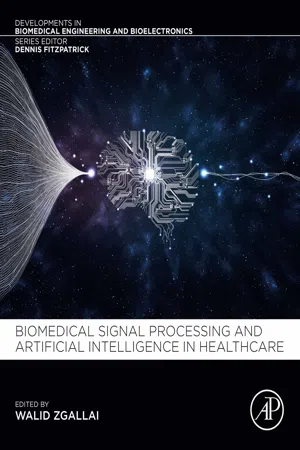
- 268 pages
- English
- ePUB (mobile friendly)
- Available on iOS & Android
Biomedical Signal Processing and Artificial Intelligence in Healthcare
About this book
Biomedical Signal Processing and Artificial Intelligence in Healthcare is a new volume in the Developments in Biomedical Engineering and Bioelectronics series. This volume covers the basics of biomedical signal processing and artificial intelligence. It explains the role of machine learning in relation to processing biomedical signals and the applications in medicine and healthcare. The book provides background to statistical analysis in biomedical systems. Several types of biomedical signals are introduced and analyzed, including ECG and EEG signals. The role of Deep Learning, Neural Networks, and the implications of the expansion of artificial intelligence is covered. Biomedical Images are also introduced and processed, including segmentation, classification, and detection. This book covers different aspects of signals, from the use of hardware and software, and making use of artificial intelligence in problem solving.Dr Zgallai's book has up to date coverage where readers can find the latest information, easily explained, with clear examples and illustrations. The book includes examples on the application of signal and image processing employing artificial intelligence to Alzheimer, Parkinson, ADHD, autism, and sleep disorders, as well as ECG and EEG signals. Developments in Biomedical Engineering and Bioelectronics is a 10-volume series which covers recent developments, trends and advances in this field. Edited by leading academics in the field, and taking a multidisciplinary approach, this series is a forum for cutting-edge, contemporary review articles and contributions from key 'up-and-coming' academics across the full subject area. The series serves a wide audience of university faculty, researchers and students, as well as industry practitioners.- Coverage of the subject area and the latest advances and applications in biomedical signal processing and Artificial Intelligence- Contributions by recognized researchers and field leaders- On-line presentations, tutorials, application and algorithm examples
Frequently asked questions
- Essential is ideal for learners and professionals who enjoy exploring a wide range of subjects. Access the Essential Library with 800,000+ trusted titles and best-sellers across business, personal growth, and the humanities. Includes unlimited reading time and Standard Read Aloud voice.
- Complete: Perfect for advanced learners and researchers needing full, unrestricted access. Unlock 1.4M+ books across hundreds of subjects, including academic and specialized titles. The Complete Plan also includes advanced features like Premium Read Aloud and Research Assistant.
Please note we cannot support devices running on iOS 13 and Android 7 or earlier. Learn more about using the app.
Information
Chapter 1: Introduction to biomedical signal processing and artificial intelligence
Abstract
Keywords
1.1: Introduction to signal processing

- (1) Eliminating noise: A noisy electrocardiograph can exhibit discontinuous behavior of the recorded signal. We know from the biology that the electrical activity of the heart should behave in a smooth fashion. Thus the goal of signal processing would be to eliminate or reduce noise and produce a clean signal that reflects the true underlying activity of the heart in a patient.
- (2) Correction of distortion: Running a blurry image through a signal processing algorithm that can reconstruct a sharper, more focused image. Correcting distortion of images can be obvious; however, this can also be applied to signals being distorted in time.
- (3) Extracting information embedded within the measured signals: For example, using a radar system to determine an aircraft position and velocity. Firstly, the position of the aircraft is governed by the time delay that it took for a pulse to travel from the radar to the airplane and back, and knowing the speed of light, we can figure out how far away it was. Secondly the relative velocity of the airplane with respect to the radar is embedded in the Doppler shift that can be seen in the received pulse.
Table of contents
- Cover image
- Title page
- Table of Contents
- Copyright
- Dedication
- Contributors
- Foreword
- Preface
- Chapter 1: Introduction to biomedical signal processing and artificial intelligence
- Chapter 2: Characterization of biomedical signals: Feature engineering and extraction
- Chapter 3: Supervised and unsupervised learning
- Chapter 4: Machine learning in biomedical signal processing with ECG applications
- Chapter 5: Deep EEG: Deep learning in biomedical signal processing with EEG applications
- Chapter 6: Fuzzy logic in medicine
- Chapter 7: Neural network applications in medicine
- Chapter 8: Analysis and management of sleep data
- Index